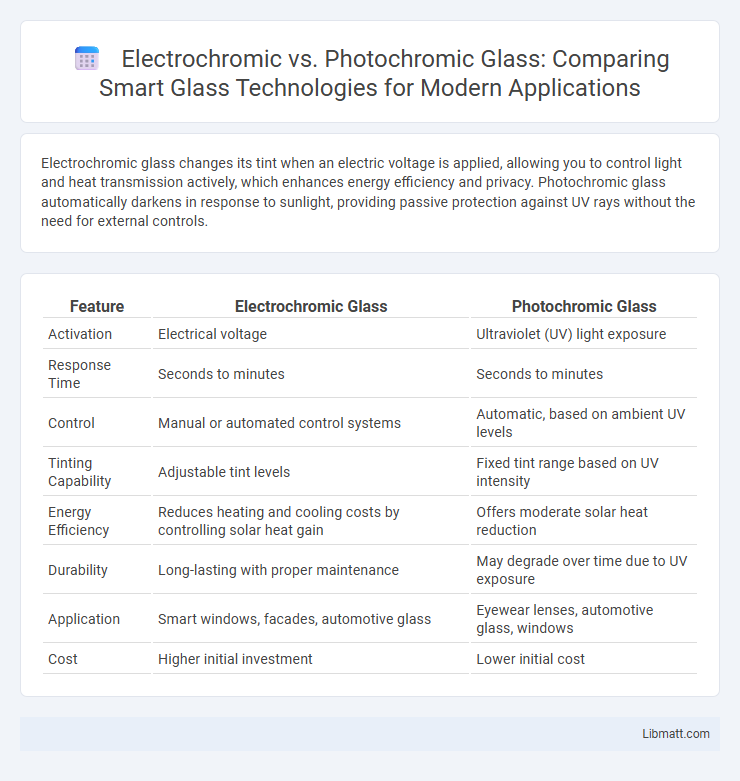Electrochromic glass changes its tint when an electric voltage is applied, allowing you to control light and heat transmission actively, which enhances energy efficiency and privacy. Photochromic glass automatically darkens in response to sunlight, providing passive protection against UV rays without the need for external controls.
Table of Comparison
| Feature | Electrochromic Glass | Photochromic Glass |
|---|---|---|
| Activation | Electrical voltage | Ultraviolet (UV) light exposure |
| Response Time | Seconds to minutes | Seconds to minutes |
| Control | Manual or automated control systems | Automatic, based on ambient UV levels |
| Tinting Capability | Adjustable tint levels | Fixed tint range based on UV intensity |
| Energy Efficiency | Reduces heating and cooling costs by controlling solar heat gain | Offers moderate solar heat reduction |
| Durability | Long-lasting with proper maintenance | May degrade over time due to UV exposure |
| Application | Smart windows, facades, automotive glass | Eyewear lenses, automotive glass, windows |
| Cost | Higher initial investment | Lower initial cost |
Introduction to Smart Glass Technologies
Electrochromic glass and photochromic glass are advanced smart glass technologies designed to enhance energy efficiency and comfort by dynamically controlling light transmission. Electrochromic glass changes tint through electrical voltage applied to its layers, allowing precise control over transparency and heat gain. Photochromic glass automatically adjusts its tint in response to sunlight intensity, providing an adaptive solution without user intervention.
What is Electrochromic Glass?
Electrochromic glass is a smart window technology that changes its tint when an electrical voltage is applied, allowing precise control over light transmission and heat reduction. This glass improves energy efficiency by reducing glare and ultraviolet radiation while maintaining visibility. You can enhance comfort and privacy in buildings or vehicles by integrating electrochromic glass into your design.
What is Photochromic Glass?
Photochromic glass contains molecules that react to ultraviolet (UV) light, causing the glass to darken when exposed to sunlight and revert to clear indoors. This adaptive property enhances visual comfort and reduces glare without requiring electrical power. Commonly used in eyeglasses and windows, photochromic glass offers passive light control through chemical reactions triggered by UV radiation.
Core Differences: Electrochromic vs Photochromic Glass
Electrochromic glass changes its tint in response to an electric voltage, allowing precise control over light transmission and privacy through smart windows or automotive applications. Photochromic glass automatically darkens when exposed to ultraviolet (UV) light, providing a hands-free, reactive tint mainly used in eyewear and some architectural glazing. The core difference lies in the activation method and control: electrochromic glass offers adjustable, user-controlled shading, whereas photochromic glass relies on environmental UV exposure for automatic light modulation.
How Electrochromic Glass Works
Electrochromic glass operates by applying a low voltage to change the opacity or tint of the glass, enabling dynamic control over light and heat transmission. This technology uses multiple layers, including a transparent electrode, electrochromic layer, and ion conductor, which work together to reversibly alter the glass's color or transparency when an electrical charge is applied. Your energy efficiency and comfort improve as electrochromic glass adjusts automatically or manually in response to sunlight and temperature changes.
How Photochromic Glass Works
Photochromic glass contains molecules that change structure in response to ultraviolet (UV) light, causing the glass to darken automatically when exposed to sunlight. These molecules undergo a reversible chemical reaction that shifts their absorption spectrum, allowing the glass to return to a clear state indoors or in the absence of UV rays. This dynamic adjustment enhances comfort and UV protection without the need for electrical input, distinguishing it from electrochromic glass, which relies on an applied voltage to change tint.
Advantages of Electrochromic Glass
Electrochromic glass offers precise control over light transmission, allowing you to adjust tint levels instantly with the flip of a switch, enhancing energy efficiency by reducing the need for artificial lighting and air conditioning. It provides superior durability and long-lasting performance compared to photochromic glass, which relies on UV exposure and changes tint passively. The ability of electrochromic glass to selectively block heat while maintaining natural daylight improves indoor comfort and reduces overall energy costs.
Advantages of Photochromic Glass
Photochromic glass offers the advantage of automatically adjusting to changing light conditions by darkening in response to UV rays, enhancing visual comfort and reducing glare without any manual intervention. This adaptive feature helps protect your eyes from harmful ultraviolet radiation while maintaining clear vision indoors and outdoors. Its energy-efficient properties contribute to reducing the need for additional window treatments or sunglasses, supporting both convenience and sustainability.
Applications in Architecture and Automotive
Electrochromic glass offers dynamic control over light and heat transmission, making it ideal for smart windows in architectural designs and automotive sunroofs, enhancing energy efficiency and occupant comfort. Photochromic glass darkens automatically in response to UV exposure, providing passive glare reduction primarily in automotive windows and eyewear but with limited application in building facades. Your choice depends on whether you need active, user-controlled tinting or adaptive, sunlight-responsive shading for your project.
Choosing the Right Smart Glass for Your Needs
Electrochromic glass offers dynamic tint control through electrical signals, ideal for precise light management and energy savings in buildings. Photochromic glass changes tint automatically in response to UV light, providing convenient, hands-free shading for outdoor use. Understanding your environment and control preferences will help you choose the smart glass that best matches your comfort and energy efficiency goals.
Electrochromic vs photochromic glass Infographic

 libmatt.com
libmatt.com